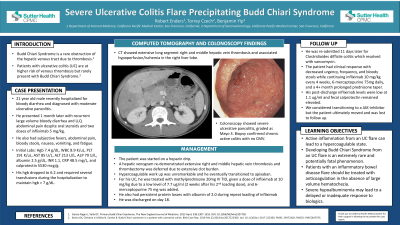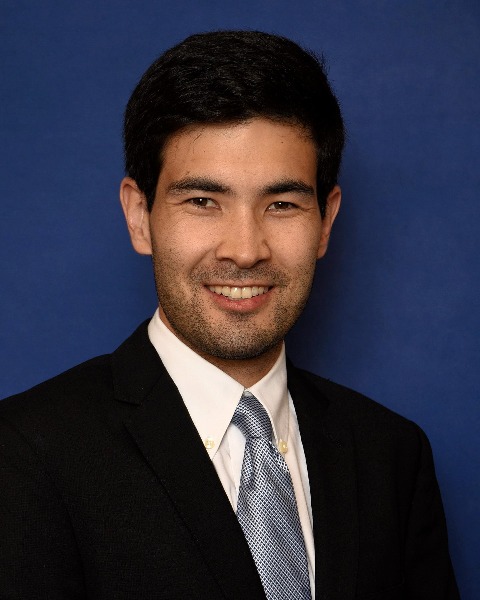Sunday Poster Session
Category: IBD
P1008 - Severe Ulcerative Colitis Precipitating Budd Chiari Syndrome
Sunday, October 27, 2024
3:30 PM - 7:00 PM ET
Location: Exhibit Hall E

Has Audio

Robert Enders, MD, MS
California Pacific Medical Center
San Francisco, CA
Presenting Author(s)
Robert Enders, MD, MS, Torrey Czech, MD, Benjamin Yip, MD
California Pacific Medical Center, San Francisco, CA
Introduction: Budd Chiari Syndrome (BCS) is a rare obstruction of the hepatic venous tract due to thrombosis and primarily affects younger patients. Patients with ulcerative colitis (UC) are at higher risk of venous thrombosis but rarely present with BCS.
Case Description/Methods: A 21 year old male with recently diagnosed ulcerative pancolitis presented with recurrent large volume bloody diarrhea and LLQ abdominal pain despite oral steroids and two doses of infliximab 5 mg/kg.
He presented with subjective fevers, abdominal pain, bloody stools, nausea, vomiting, and fatigue. He was afebrile, hemodynamically stable, ill-appearing with hyperactive bowel sounds and diffuse abdominal tenderness. Initial labs were notable for Hgb 7.4, WBC 8.9, PLT 191, AST 85, ALT 213, ALP 79, albumin 2.5, INR 1.1, CRP 48.5, and calprotectin 5530 mcg/g. Ceruloplasmin, 24 hr urine copper, IgG, HAV IgM, HBcAb, HbsAg, HCV PCR, ANA, LKM, AMA, ASMA and A1AT were normal. HAV IgG and HbsAb were positive. DVT prophylaxis was held given concern for bleeding. A CT showed extensive long segment right and middle hepatic vein thrombosis, associated hypoperfusion/ischemia in the right liver lobe. Given new BCS, he was transferred to our hospital for higher level of care.
He was started on a heparin drip and hepatic venogram re-demonstrated extensive right and middle hepatic vein thrombosis and thrombectomy was deferred due to extensive clot burden. A hypercoagulable workup was unremarkable and he eventually transitioned to apixaban. On day 7, colonoscopy showed Mayo 3 pancolitis and biopsies confirmed chronic active colitis with no CMV. For his UC, he was continued on methylprednisolone 20 mg TID, given a dose of infliximab at 10 mg/kg due to a level of 7.7 ug/ml (2 weeks after his 2nd loading dose), and 6-MP 75mg was added. He was discharged on day 18.
A month later, he was clinically responding with mild abdominal pain and 2-3 non-bloody BMs per day. He remained on apixaban and 6-MP, continued to taper his steroids, and infliximab was escalated to every 4 weeks. A repeat CT showed partial resolution of the thrombus and his liver labs normalized.
Discussion: While active inflammation from a UC flare can lead to a hypercoagulable state, developing BCS is an extremely rare and potentially fatal phenomenon. It is important to consider BCS in IBD patients who present with abdominal pain, distension, and abnormal liver function tests. All patients with an IBD flare should be treated with anticoagulation in the absence of large volume hematochezia.

Disclosures:
Robert Enders, MD, MS, Torrey Czech, MD, Benjamin Yip, MD. P1008 - Severe Ulcerative Colitis Precipitating Budd Chiari Syndrome, ACG 2024 Annual Scientific Meeting Abstracts. Philadelphia, PA: American College of Gastroenterology.
California Pacific Medical Center, San Francisco, CA
Introduction: Budd Chiari Syndrome (BCS) is a rare obstruction of the hepatic venous tract due to thrombosis and primarily affects younger patients. Patients with ulcerative colitis (UC) are at higher risk of venous thrombosis but rarely present with BCS.
Case Description/Methods: A 21 year old male with recently diagnosed ulcerative pancolitis presented with recurrent large volume bloody diarrhea and LLQ abdominal pain despite oral steroids and two doses of infliximab 5 mg/kg.
He presented with subjective fevers, abdominal pain, bloody stools, nausea, vomiting, and fatigue. He was afebrile, hemodynamically stable, ill-appearing with hyperactive bowel sounds and diffuse abdominal tenderness. Initial labs were notable for Hgb 7.4, WBC 8.9, PLT 191, AST 85, ALT 213, ALP 79, albumin 2.5, INR 1.1, CRP 48.5, and calprotectin 5530 mcg/g. Ceruloplasmin, 24 hr urine copper, IgG, HAV IgM, HBcAb, HbsAg, HCV PCR, ANA, LKM, AMA, ASMA and A1AT were normal. HAV IgG and HbsAb were positive. DVT prophylaxis was held given concern for bleeding. A CT showed extensive long segment right and middle hepatic vein thrombosis, associated hypoperfusion/ischemia in the right liver lobe. Given new BCS, he was transferred to our hospital for higher level of care.
He was started on a heparin drip and hepatic venogram re-demonstrated extensive right and middle hepatic vein thrombosis and thrombectomy was deferred due to extensive clot burden. A hypercoagulable workup was unremarkable and he eventually transitioned to apixaban. On day 7, colonoscopy showed Mayo 3 pancolitis and biopsies confirmed chronic active colitis with no CMV. For his UC, he was continued on methylprednisolone 20 mg TID, given a dose of infliximab at 10 mg/kg due to a level of 7.7 ug/ml (2 weeks after his 2nd loading dose), and 6-MP 75mg was added. He was discharged on day 18.
A month later, he was clinically responding with mild abdominal pain and 2-3 non-bloody BMs per day. He remained on apixaban and 6-MP, continued to taper his steroids, and infliximab was escalated to every 4 weeks. A repeat CT showed partial resolution of the thrombus and his liver labs normalized.
Discussion: While active inflammation from a UC flare can lead to a hypercoagulable state, developing BCS is an extremely rare and potentially fatal phenomenon. It is important to consider BCS in IBD patients who present with abdominal pain, distension, and abnormal liver function tests. All patients with an IBD flare should be treated with anticoagulation in the absence of large volume hematochezia.

Figure: CT scan demonstrating hypoperfusion/ischemia in the right liver lobe in the setting of long segment right and middle hepatic vein thrombosis.
Disclosures:
Robert Enders indicated no relevant financial relationships.
Torrey Czech indicated no relevant financial relationships.
Benjamin Yip indicated no relevant financial relationships.
Robert Enders, MD, MS, Torrey Czech, MD, Benjamin Yip, MD. P1008 - Severe Ulcerative Colitis Precipitating Budd Chiari Syndrome, ACG 2024 Annual Scientific Meeting Abstracts. Philadelphia, PA: American College of Gastroenterology.
